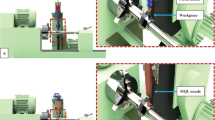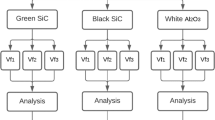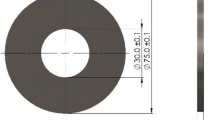Abstract
Usually, the applications of the VP50IM steel demand the grinding process during their manufacturing process (dies for thermoplastics extrusion and molds for thermoplastics injection). Nowadays, grinding is a process that involves high specific energy, highlighting the importance of adopting a method of heat management. Cutting fluids to cool and lubricate the cutting zone is one of the villains of achieving green manufacturing. Therefore, researchers are developing new methodologies to reduce or even eliminate the use of cutting fluids. Minimum quantity lubrication (MQL) was designed to minimize cutting fluid utilization, contributing to an eco-friendly machining process. This paper studies the application of the MQL in the grinding of VP50IM steel using green silicon carbide grinding wheel. The flood condition was the basis of comparison and three feed rates: 0.25, 0.50, and 0.75 mm/min. The analyzed output parameters were: surface roughness, roundness errors, grinding power, grinding wheel wear, microhardness, and metallographic analysis. The best results were provided by the lowest feed rate, since as lower the feed rate, the smoother the cutting process. The surface roughness provided by the MQL was 14% higher than the results provided by the flood condition, which indicates the potential of this new green technique to be adopted in the grinding process.









Similar content being viewed by others
References
Klocke F, Brinksmeier E, Weinert K (2005) Capability profile of hard cutting and grinding processes. CIRP Ann 54:22–45. https://doi.org/10.1016/s0007-8506(07)60018-3
Zahedi A, Tawakoli T, Azarhoushang B, Akbari J (2015) Picosecond laser treatment of metal-bonded CBN and diamond superabrasive surfaces. Int J Adv Manuf Technol 76:1479–1491. https://doi.org/10.1007/s00170-014-6383-5
Webster J, Tricard M (2004) Innovations in abrasive products for precision grinding. CIRP Ann 53:597–617. https://doi.org/10.1016/S0007-8506(07)60031-6
Azarhoushang B, Zahedi A (2017) Laser conditioning and structuring of grinding tools – a review. Adv Manuf 5:35–49. https://doi.org/10.1007/s40436-016-0167-0
Zahedi A, Azarhoushang B (2016) Laser-profiling of metal-bonded diamond grinding wheels. In: Materials Science Forum. Trans Tech Publications Ltd, pp 272–276
Zahedi A, Khosravi J, Azarhoushang B (2021) Grinding efficiency and profile accuracy of diamond grinding wheels dressed with wire electrical discharge conditioning (WEDC). Int J Adv Manuf Technol 117:2163–2171. https://doi.org/10.1007/s00170-021-07114-2
Beranoagirre A, López de Lacalle LN (2013) Grinding of gamma TiAl intermetallic alloys. Procedia Engineering 63:489–498. https://doi.org/10.1016/J.PROENG.2013.08.182
da Silva AE, Cuesta JL, Lopes JC et al (2021) Grinding behavior of VP50IM steel using green and black silicon carbide compared to aluminum oxide wheel under different feed rates. Int J Adv Manuf Technol 117:2639–2653. https://doi.org/10.1007/s00170-021-07826-5
Hähnel S, Grunwald T, Bergs T et al (2020) Vibration-assisted face grinding of mould steel. pp 291–303
Huang W-T, Liu W-S, Tsai J-T, Chou J-H (2017) Multiple quality characteristics of nanofluid/ultrasonic atomization minimum quality lubrication for grinding hardened mold steel. IEEE Trans Autom Sci Eng 15:1065–1077
Li H, Yu T, Zhu L, Wang W (2015) Analysis of loads on grinding wheel binder in grinding process: insights from discontinuum-hypothesis-based grinding simulation. Int J Adv Manuf Technol 78:1943–1960
Chaudhari A, Sharma A, Awale AS et al (2022) Modeling and simulation study of dry ultrasonic vibration-assisted grinding of tool steel with single alumina abrasive grit. J Manuf Sci Eng 144. https://doi.org/10.1115/1.4054602
Chaudhari A, Yusufzai MZK, Vashista M (2021) Grindability study of hard to cut AISI D2 steel upon ultrasonic vibration-assisted dry grinding 236:915–925. https://doi.org/10.1177/09544089211051635
Sharma A, Khan Yusufzai MZ, Vashista M (2022) A comparative analysis of grinding of AISI D2 tool steel under different environments. 26:183–202. https://doi.org/10.1080/10910344.2022.2044853
Jawahir IS, Attia H, Biermann D et al (2016) Cryogenic manufacturing processes. CIRP Ann Manuf Technol 65:713–736. https://doi.org/10.1016/j.cirp.2016.06.007
Bianchi EC, Rodriguez RL, Hildebrandt RA et al (2018) Plunge cylindrical grinding with the minimum quantity lubrication coolant technique assisted with wheel cleaning system. Int J Adv Manuf Technol 95:2907–2916. https://doi.org/10.1007/s00170-017-1396-5
Sato BK, Lopes JC, Rodriguez RL et al (2022) Novel comparison concept between CBN and Al2O3 grinding process for eco-friendly production. J Clean Prod 330:129673. https://doi.org/10.1016/j.jclepro.2021.129673
Awale AS, Vashista M, Khan Yusufzai MZ (2020) Multi-objective optimization of MQL mist parameters for eco-friendly grinding. J Manuf Process 56:75–86. https://doi.org/10.1016/J.JMAPRO.2020.04.069
Rodriguez RL, Lopes JC, Garcia MV et al (2020) Application of hybrid eco-friendly MQL+WCJ technique in AISI 4340 steel grinding for cleaner and greener production. J Clean Prod 124670. https://doi.org/10.1016/j.jclepro.2020.124670
de Moraes DL, Garcia MV, Lopes JC et al (2019) Performance of SAE 52100 steel grinding using MQL technique with pure and diluted oil. Int J Adv Manuf Technol 105:4211–4223. https://doi.org/10.1007/s00170-019-04582-5
Lopes JC, de Martini FL, Domingues BB et al (2019) Effect of CBN grain friability in hardened steel plunge grinding. Int J Adv Manuf Technol 103:1567–1577. https://doi.org/10.1007/s00170-019-03654-w
dos Anjos MA, Bianchi EC, de Mello HJ et al (2016) Experimental study of the use of conventional wheels on steel processing VP-50 used in the cylindrical grinding by means of different methods of lubrication and cooling. Matéria (Rio de Janeiro) 21:169–184
Sato BK, Rodriguez RL, Talon AG et al (2019) Grinding performance of AISI D6 steel using CBN wheel vitrified and resinoid bonded. Int J Adv Manuf Technol 105:2167–2182. https://doi.org/10.1007/s00170-019-04407-5
Wang H, Ning F, Hu Y, Cong W (2018) Surface grinding of CFRP composites using rotary ultrasonic machining: a comparison of workpiece machining orientations. Int J Adv Manuf Technol 95:2917–2930
Rabiei F, Rahimi AR, Hadad MJ, Ashrafijou M (2015) Performance improvement of minimum quantity lubrication (MQL) technique in surface grinding by modeling and optimization. J Clean Prod 86:447–460. https://doi.org/10.1016/j.jclepro.2014.08.045
de Sampaio Alves LOB, Bianchi EC, de Aguiar PR et al (2017) External plunge grinding of the n2711 steel for plastic injection mold with two different techniques of lubrication and cooling
Cai R, Rowe WB (2004) Assessment of vitrified CBN wheels for precision grinding. Int J Mach Tools Manuf. https://doi.org/10.1016/J.IJMACHTOOLS.2004.04.004
Acknowledgements
The authors are also thankful to companies Abrasipa Indústria de Abrasivos Ltda. for supplying the grinding wheel and Quimatic Tapmatic Ltda. for donating MQL.
Funding
The authors are thankful to the Coordination for the Improvement of Higher Level Education Personnel (CAPES), National Council for Scientific and Technological Development (CNPq).
Author information
Authors and Affiliations
Contributions
Bruno Kenta Sato: Writing original draft; writing review and editing; visualization; conceptualization; formal analysis; investigation; validation. Fernando Sabino Fonteque Ribeiro: Writing original draft; writing review and editing; visualization; conceptualization. Rafael Lemes Rodriguez: Writing original draft; writing review and editing; visualization; conceptualization; formal analysis; investigation; validation. José Claudio Lopes: Writing original draft; resources; conceptualization; methodology; project administration. Luiz Eduardo de Angelo Sanchez: Writing—review and editing; conceptualization; supervision. Eduardo Carlos Bianchi: Funding acquisition; conceptualization; resources; supervision; project administration.
Corresponding author
Ethics declarations
Ethics approval
The authors declare that this manuscript was not submitted to more than one journal for simultaneous consideration. Also, the submitted work is original and not have been published elsewhere in any form or language.
Consent to participate
The authors declare that they participated in this paper willingly and the authors declare to consent to the publication of this paper.
Consent for publication
The authors declare that they participated in this paper willingly and the authors declare to consent to the publication of this paper.
Competing interests
The authors declare no competing interests.
Additional information
Publisher's Note
Springer Nature remains neutral with regard to jurisdictional claims in published maps and institutional affiliations.
Rights and permissions
About this article
Cite this article
Sato, B.K., Lopes, J.C., Ribeiro, F.S.F. et al. Evaluating the effect of MQL technique in grinding VP50IM steel with green carbide wheel. Int J Adv Manuf Technol 121, 7287–7294 (2022). https://doi.org/10.1007/s00170-022-09813-w
Received:
Accepted:
Published:
Issue Date:
DOI: https://doi.org/10.1007/s00170-022-09813-w




